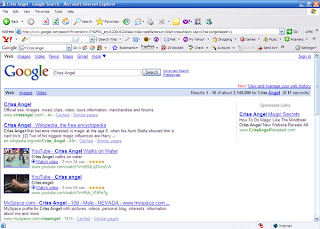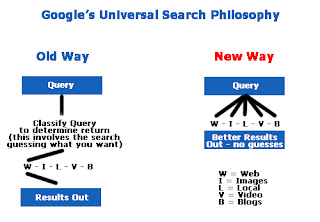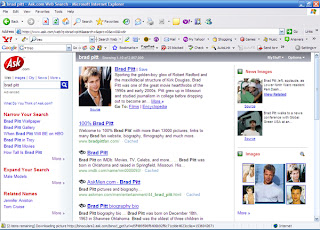Day 1
11-12:30 pm
Universal & Blended Vertical Search – discussed how search engines are evolving to include video, blog, maps, local info, and more on their SERPs (that means Search Engines Results Pages). Our moderator was Chris Sherman of SES San Jose.
6 speakers on this panel gave us great info:
Greg Jarobe, SEO – PR
Sherwood Stanieri, Catalyst Online
Bill Slawski, Commerce 360
David Bailey, Google
Somebody from Yahoo, sorry I didn’t get your name 🙁
Daniel Read, Ask
First off, what is a Universal Search? In laymans terms, Universal Search is the inclusion of multimedia and news resources on one search results page. Why is universal search getting so big? Well, it makes life easier for the client.
Let’s start with Speaker 1, Greg Jarboe. Greg did some case studies on popular search terms to see what Google was pulling – Video? Pictures? Articles? Blogs? As you know, most searches in Google now bring up all of the above. This CHANGES our old organic model of the Golden Triangle and makes MORE of the SERP relevant. It pushes DOWN some of our organic web results, and brings much more video and blogs into the big picture.
I think this is a good thing for SERPs, I especially like that there are interesting options along the bottom now, so that users are encouraged to look all the way down there. Did you know there are 98 Million blogs now? If you’re not blogging you may be missing out on some search engine status. In addition, if you are not submitting your press releases to the best news sites (see http://www.newsknife.com/ and Google News http://news.google.com/ for the best ones) you are missing out on status. An interesting tid bit for your releases – submit a relevant .jpg with them and they are more likely to get indexed. 🙂
Speaker #2 Sherwood Stanieri did a comparison with Universal Search and “are we comparing Apples to Oranges?” His main focus was “GUS”, Google Universal System. Google currently has 50% market share in blended/universal search so they are a good candidate to pick apart. Sherwood asked the question how does blended search handle video? What do they consider? We found that video searches are rated based off 4 factors:
Content – what is the content in your video
Linking – what sites are linking to your video
Views – what and how many people are viewing your video
Comments – what do the user comments on your video say
Traditional Organic SEO considers different factors: current site ranking, page rank, Yahoo page links, meta tag keyphrases, etc. Sherwood attempted to layer the two and try to find a common denominator between them, or try to find out the biggest factors driving video search. After his comparison with A & E’s site using Kriss Angel, we found out that comments are a key factor, and so are using traditional organic SEO techniques.
 Speaker #3, Bill Slawski, posed the questions “How do search engines determine WHAT vertical results to place in the SERPs?” and “Why do we sometimes see video? Blogs? News? Weather? How does the search choose?” He had a really neat slide on the Evolution of Universal search… it actually started in 1995 with InfoSeek’s blended search, and Google later bought their patent. Bill discussed how “tagging” and “instances” could be considered, as well as the searcher location and time of day. THIS throws a major consideration into Cal Coast’s organic SEO, because we now know that people searching on one side of the country may see different results than people on the other side of the country. We need to optimize for everyone, don’t we? How can we? I asked the question later in the session, you’re NOT going to like the answer. They basically told me there isn’t really any real way, besides manually trying to change your IP address. Oh ya, they also told me I could call a friend on the other side of the country and ask what they see. Duh, already do that…need a better way…Web Position Gold…please do something quick!
Speaker #3, Bill Slawski, posed the questions “How do search engines determine WHAT vertical results to place in the SERPs?” and “Why do we sometimes see video? Blogs? News? Weather? How does the search choose?” He had a really neat slide on the Evolution of Universal search… it actually started in 1995 with InfoSeek’s blended search, and Google later bought their patent. Bill discussed how “tagging” and “instances” could be considered, as well as the searcher location and time of day. THIS throws a major consideration into Cal Coast’s organic SEO, because we now know that people searching on one side of the country may see different results than people on the other side of the country. We need to optimize for everyone, don’t we? How can we? I asked the question later in the session, you’re NOT going to like the answer. They basically told me there isn’t really any real way, besides manually trying to change your IP address. Oh ya, they also told me I could call a friend on the other side of the country and ask what they see. Duh, already do that…need a better way…Web Position Gold…please do something quick!
Speaker #4 was our Google guy David Bailey. David re-iterated to us Google’s simplistic motto: “Organize the world’s info and make it universally accessible and useful”. Google loves Universal Search, because it helps to do exactly what the motto states. Google’s goals with GUS are:
1. Google Searchbox is the first resort
2. Searches should display special features and results (aka video, news, blogs, whatever is special but relevant)
3. KEEP IT RELEVANT, duh, its google 🙂
David had a great drawing describing Google’s old and new way of searching, here is my rendition:
 He also gave a tidbit that you can register your business with Google even if you don’t have a website (or good website) to be found in local results. Cal Coast will figure out the best way to do this, and do it for all of our clients soon 🙂 Lastly, David reminded us to submit our feeds to Google Products (formerly Froogle) for selling merchandise. We do already do this for our clients who have products, FYI.
He also gave a tidbit that you can register your business with Google even if you don’t have a website (or good website) to be found in local results. Cal Coast will figure out the best way to do this, and do it for all of our clients soon 🙂 Lastly, David reminded us to submit our feeds to Google Products (formerly Froogle) for selling merchandise. We do already do this for our clients who have products, FYI.
DUUUUUDE, I take so many notes haha
Speaker #5 was our Yahoo guy. He spoke briefly of the history of the Vertical Creep…phase 1 was optimizing content selection, phase 2 was appearance of options, now phase 3 is dynamic integration and the QUALITY of the options in phase 2.
It almost sounded to me when he was speaking that the goal of Yahoo as of late is to KEEP the user at Yahoo by providing them with more depth and wealth of information…so much so that they do not have to go to your website anymore!? Is this good or bad? It’s both, in my opinion. I like to be able to Google or Y! a business on my treo, and get the address without going to the site.
As an SEO, do I like it that Y! is trying to be more sticky and not send as many clickthroughs to sites? UM….. NO….., that means less clickthroughs to our clients! I am sure Yahoo will find the best happy medium though. A major point for businesses to remember is that people can find out so much about you, without ever going to your website. You need to optimize videos, blogs, everything so you appear credible; and users DO clickthrough to your site.
One thing I thought was very cool was Yahoo’s “expando” arrow. They will show traditional results with an arrow you can expand to find other relevant pictures, video, blogs, news, and common search queries. I like this, it keeps the results short but totally relevant. 🙂 I just did a couple searches though and its not implemented everywhere yet. Booooo.
The last speaker was Daniel Reed from Ask. He mentioned that Ask has seen the following behavior changes in the searcher since the inception of their 3D search recently:
-increased retention
-30% drop in people going to page 2 of SERPs (so get on page one people, it’s the most relevant!) -users interacting with MORE of the page (goes back to golden pyramid is changing), I hope they will post the eye chart soon so you can compare differences.
Daniel also reminded us that Location plays a much bigger role now in Ask’s blended search, as does your online reputation; it better be good 🙂 He also mentioned there are less web results and an even mix of blogs, video and images for user relevancy and ease of use. Cool. I like how they have 3 panels, and the left panel scrolls with you as you look down the page. Have you seen it? I give it TWO THUMBS UP!




